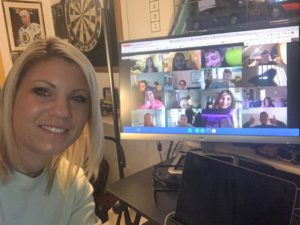
Tracy Norton with her students
By Peg Lopata, Contributing writer
GRAFTON – Even in the best of times, teaching is hard work.
During this pandemic it’s been even harder. This has hit home for Tracy Norton, third grade teacher at North Street Elementary.
“My favorite part of teaching is seeing my students laugh, smile and interact with each other,” said Norton. “Being on a screen has made this difficult for the kids and me to do these things.”
Meeting the challenge
Though students are largely back in the classroom now after COVID-19 reopenings, teachers like Norton found unique ways to encourage engagement over months of hybrid learning.
“I wanted the kids to get excited about learning so I could see those smiles and excitement again,” she explained.
So with some research on how to do remote field trips that help enrich the curriculum, the students have “hit the road” — remotely, that is. Starting in January and continuing through at least the beginning of last month, her students with teacher, Emma Marsland’s fifth graders have gone on a virtual field trip every week.
Oh, the places you will go!
Since their first remote trip to Thomas Jefferson’s former plantation and home, Monticello Mansion, in Charlottesville, VA, the students have been aboard a Boston tea party ship, at the Pacific Science Center, Seattle, WA and a planetarium. They also went to the Museum of the American Revolution, Philadelphia, PA.
Making Learning Live
After the trip to Jefferson’s plantation Norton could see this type of learning was a success.
“The kids couldn’t stop chatting about the trip,” said Norton. “I saw excitement and a level of interest I’d not seen all year on the screen. They immediately asked to go on another trip!”
One of Norton’s students remarked, “I like that we’re talking to a real person at a real place. It feels real and is way better than a movie.”
Another sign of success is that everyone shows up and the students are attentive.
“Their questions for the educator who toured the kids around Monticello were well thought out,” said Norton.
Tech Goes Home
The ability to bring students to places remotely has been possible because of tech tools, such as the active board, a giant projector, in a classroom. One group of students uses this screen to go on the trips, the other group uses their own screens at their homes. Everyone can see the live presenter.
After the trip, the students see one another using Zoom or Google Meets. For kids who miss a trip or want to revisit any of the destinations, all trips are recorded.
Making the best of things
For teachers who love really being with their students, that is face-to-face, Norton found a way to make that almost happen. They spent months unable to enjoy one another as they’re used to, but these virtual visits made for engaged students plus satisfied teachers which equals good education.

















